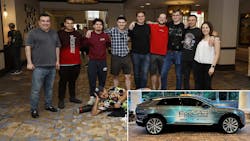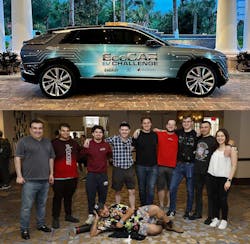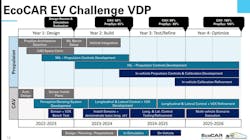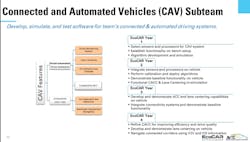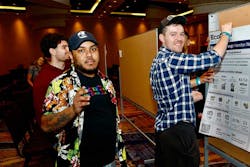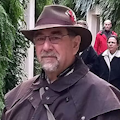Engineering Students Compete to Shape the Future of EVs
Members can download this article in PDF format.
What you’ll learn:
- A four-year design competition is inviting engineering students to try their hand at improving General Motors’ most advanced EV.
- This event is the latest in a series of government-sponsored student design competitions that’s been helping develop cleaner, safer, and more efficient vehicles for 35 years.
- How the competition's rigorous process of integrated design, analysis, simulation, and testing gives students real-world industry experience while providing automakers with fresh insights on EV design.
Why on Earth would General Motors invite a bunch of college students to hack up, hop up, and second-guess the engineering that went into one of its most advanced EVs? It's not as crazy as you might first think, and part of a long-standing four-year collegiate engineering competition, known as the EcoCAR EV Challenge (Fig. 1). The event is the latest in an ongoing collaboration between the Department of Energy Advanced Vehicle Technology Competitions (AVTC) and leading automakers, managed by Argonne National Laboratory and sponsored by the U.S. Department of Energy (DoE)*.
In this challenge, 15 teams of engineering students are demonstrating the potential of advanced propulsion systems, connected and automated vehicle (CAV) systems, and other innovative technologies to analyze energy efficiency. They will utilize a combination of on-board sensors and bidirectional vehicle-to-everything (V2X) connectivity to implement energy-efficient and customer-pleasing automated control features. This includes retrofitting GM's latest EV with an advanced powertrain, enhanced thermal systems, and new charging capabilities that allow the vehicle to intelligently use grid electricity.
The series was created 35 years ago as an opportunity to give engineering students real-world experience, while providing the auto industry with fresh insights on the art and science of creating cleaner, more efficient vehicles. Until now, though, the four-year competitions have focused on improving the efficiency, performance, and usability of conventional and hybrid vehicles, including sedans, SUVs, and even muscle cars.1
An Electrifying First
This cycle of the EcoCar Challenge is the first time that a pure battery electric vehicle (BEV) will be used as the platform to be reimagined by the student teams.
In this latest event, 15 participating teams have been tasked with enhancing the propulsion and control systems of a 2023 Cadillac LYRIQ EV to optimize energy efficiency while maintaining or exceeding consumer expectations for performance and driving experience. Likewise, the teams will also explore ways to improve the LYRIQ's connectivity, automation, and advanced driver safety functionality.
A Rigorous EcoCAR Challenge Process
To optimize the teams' chances for success, the competition's program begins by familiarizing them with the vehicle through modeling and exploring potential modifications in simulated environments.
“Year One of EcoCAR is all about generating big ideas and developing a strategy for the remainder of the competition,” said Acting Assistant Secretary for Energy Efficiency and Renewable Energy Alejandro Moreno. “These students are already demonstrating the capacity and drive needed to pursue careers in the EV sector and become trailblazers in the mobility industry.”
The Ohio State (OSU) and Wilberforce University Team has been named the winner of Year One of the EcoCAR Electric Vehicle (EV) Challenge, which was held from May 21–26, 2023 in Orlando, Florida. They took home $10,000 in prize money from industry sponsors after earning top three finishes for 12 of the pre-competition deliverables, 10 of which were first place finishes. West Virginia University took second place and University of Alabama finished third in the judged competition.
One of the main activities of the first year of the EV Challenge was a powertrain architecture selection process in which the teams evaluated a variety of motor options to use in their vehicle. As a result, each team now has a blueprint for the vehicle they will need to build during Year 2 (which starts in August of 2023).
Evaluation Stage
With Year 1 behind them, the teams' activities will begin to transition from design and planning to evaluating the proposed designs using a combination of simulation and hardware-in-the-loop (HIL) testing (Fig. 2).
During Year 2, each student team will receive a Cadillac LYRIQ BEV, provided by GM, which they will use as a platform to add and evaluate a wide range of new energy-efficient and customer-friendly features. Activities during Years Three and Four will continue to shift from simulation to hardware as the drive systems, safety systems, connectivity, and automation systems are tested, refined, and optimized.
In addition to drivetrain and control modifications, the EcoCAR teams were tasked with identifying an ASIL D-compliant compute architecture2 that could support Level 2 autonomous driving and other advanced CAV functionality specified by the competition's rules (Fig. 3). And, since the vehicle is battery-powered, they had to do it in in an energy-efficient way.
To accomplish this, the teams had to develop two architectures which could be built and decide which one would be most efficient and practical for them to use. This involved choosing between a decentralized architecture that would offload the computational load to smaller, low-power controllers and a more traditional centralized architecture based on a single control unit.
Taking a Bold Approach
One of the contributors to the OSU/Wilberforce team's first-year victory was their ambitious proposal to convert the LYRIQ's drivetrain from rear-wheel drive to an all-wheel wheel drive system.3 Although this modification offers many advantages, it also poses many additional risks and challenges for the team.
For one thing, adding a second motor to power the front wheels means that the team is on their own in terms of obtaining the unit and getting the design support they will need from the manufacturer to integrate it with the LYRIQ's electrical and mechanical systems.
Jesse Alley, the EcoCAR EV Challenge Senior Program Manager at Argonne National Laboratory, said, "This is the more challenging route to take and is precisely how OEMs within the automotive sector would have to do it."
The OSU/Wilberforce team (Fig. 4) has also proposed an advanced thermal support system that includes a heat exchanger between the stock LYRIQ system and the team-added components. The team expects that the improved thermal management provided by the support system can be used to gain a small, but significant improvement in the drivetrain's overall efficiency.
In addition, the team is ahead with many of their system designs at the end of Year 1. They have modeled and simulated their propulsion system with regard to both energy consumption and performance, packaged all components and designed preliminary mounts, and designed their auxiliary thermal and electrical support.
A Long Tradition of Innovation
As exciting as the competition's vehicles may be, the most significant outcome of these events may well culminate in the opportunities it creates and the lives it changes.
Argonne’s Jesse Alley explained, "The mission of the Advanced Vehicle Technology Competitions like EcoCAR has always been to train the next generation of engineers and business leaders. We focus on student learning more so than technology development and we’ve been successful at training engineers that quickly make an impact in the industry. Over 35 years, more than 30,000 students have participated in AVTCs. In addition, the program's participants tend to enter their first industry job at higher salaries than their peers.”
*Additional sponsors for this series include General Motors and MathWorks.
References
1. “dSPACE supports EcoCAR 3 competition,” Evaluation Engineering, May 14, 2014.
2. “ASIL D safety concept-assessed high-speed traction, bi-directional DC/DC conversion reference design,” Texas Instruments.
3. “Traction inverters – a driving force behind vehicle electrification,” Texas Instruments.
About the Author
Lee Goldberg
Contributing Editor
Lee Goldberg is a self-identified “Recovering Engineer,” Maker/Hacker, Green-Tech Maven, Aviator, Gadfly, and Geek Dad. He spent the first 18 years of his career helping design microprocessors, embedded systems, renewable energy applications, and the occasional interplanetary spacecraft. After trading his ‘scope and soldering iron for a keyboard and a second career as a tech journalist, he’s spent the next two decades at several print and online engineering publications.
Lee’s current focus is power electronics, especially the technologies involved with energy efficiency, energy management, and renewable energy. This dovetails with his coverage of sustainable technologies and various environmental and social issues within the engineering community that he began in 1996. Lee also covers 3D printers, open-source hardware, and other Maker/Hacker technologies.
Lee holds a BSEE in Electrical Engineering from Thomas Edison College, and participated in a colloquium on technology, society, and the environment at Goddard College’s Institute for Social Ecology. His book, “Green Electronics/Green Bottom Line - A Commonsense Guide To Environmentally Responsible Engineering and Management,” was published by Newnes Press.
Lee, his wife Catherine, and his daughter Anwyn currently reside in the outskirts of Princeton N.J., where they masquerade as a typical suburban family.
Lee also writes the regular PowerBites series.
